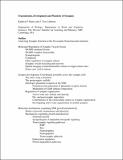Transmission, Development, and Plasticity of Synapses
Author(s)
Littleton, J. Troy; Harris, Kathryn P.
DownloadJtroyLittleton3.pdf (9.341Mb)
OPEN_ACCESS_POLICY
Open Access Policy
Creative Commons Attribution-Noncommercial-Share Alike
Terms of use
Metadata
Show full item recordAbstract
Chemical synapses are sites of contact and information transfer between a neuron and its partner cell. Each synapse is a specialized junction, where the presynaptic cell assembles machinery for the release of neurotransmitter, and the postsynaptic cell assembles components to receive and integrate this signal. Synapses also exhibit plasticity, during which synaptic function and/or structure are modified in response to activity. With a robust panel of genetic, imaging, and electrophysiology approaches, and strong evolutionary conservation of molecular components, Drosophila has emerged as an essential model system for investigating the mechanisms underlying synaptic assembly, function, and plasticity. We will discuss techniques for studying synapses in Drosophila, with a focus on the larval neuromuscular junction (NMJ), a well-established model glutamatergic synapse. Vesicle fusion, which underlies synaptic release of neurotransmitters, has been well characterized at this synapse. In addition, studies of synaptic assembly and organization of active zones and postsynaptic densities have revealed pathways that coordinate those events across the synaptic cleft. We will also review modes of synaptic growth and plasticity at the fly NMJ, and discuss how pre- and postsynaptic cells communicate to regulate plasticity in response to activity.
Date issued
2015-10Department
Massachusetts Institute of Technology. Department of Biology; Massachusetts Institute of Technology. Department of Brain and Cognitive Sciences; Picower Institute for Learning and MemoryJournal
Genetics
Publisher
Genetics Society of America (GSA)
Citation
Harris, Kathryn P., and J. Troy Littleton. “Transmission, Development, and Plasticity of Synapses.” Genetics 201, no. 2 (October 1, 2015): 345-375.
Version: Author's final manuscript
ISSN
0016-6731
1943-2631